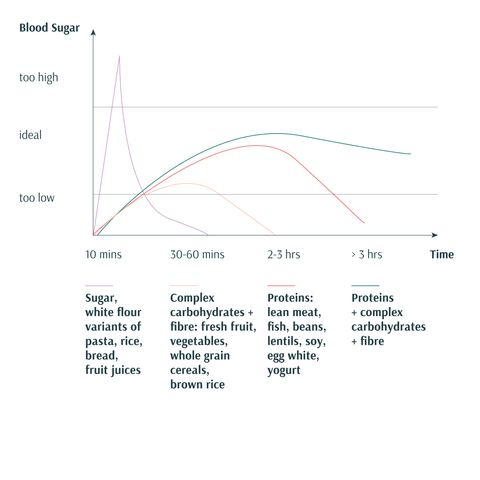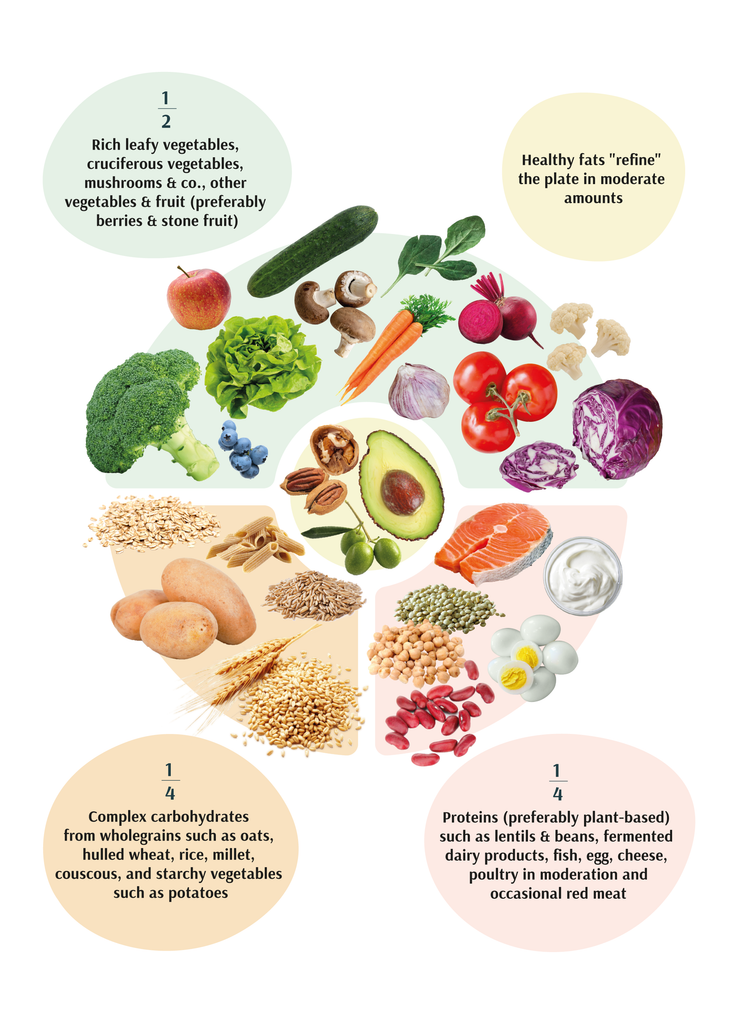How To Lose Weight After 40: What You Need To Know

Losing weight is often more difficult after 40 than at a younger age - but it is by no means impossible! Here, we’ll tell you all about losing weight from 40 onwards.
"No matter what I do, I never lose any weight."
You might know this feeling all too well.
We’ll get the bad news out of the way first: unfortunately, losing weight doesn't get any easier with age. As we get older, our weight often increases and women over 40 simply find it more difficult to lose weight. But why is that?
The interplay of hormonal changes, decreasing muscle mass and increased sensitivity to sugar cause our love handles to grow with age. Chuck in stress and worries at work or at home, coupled with other difficulties such as poor sleep, and things become even more difficult.
That doesn't sound particularly encouraging, does it? But don’t fret, there are effective, scientifically-validated strategies that women can use to lose weight even after 40.
What does science say about losing weight from 40 onwards?
Not every woman automatically gains weight during the menopause. So in a comprehensive study, researchers looked at what women who do not gain weight or only gain a minor amount of weight do differently.
They looked at both short-term and long-term lifestyle changes of almost 500 women in their 50s and how these were linked to weight changes. The researchers identified very specific eating habits that were associated with a consistent weight or even weight loss.
The result: in the long term, the women who had fewer desserts, soft drinks, cheese and meat on their plates fared best. Instead, these women ate lots of fruit and vegetables, fish and changed their exercise habits.
The most important finding of the study is that long-term weight loss success depends on how permanently and sustainably the respective dietary changes are implemented. In other words, it's a marathon not a sprint. The best results were achieved by reducing sugary foods while increasing protein, fruit and vegetables at the same time.
In other words: from the menopause onwards, women lose weight if they shift their lifestyle towards health in the long term and not through starvation and crash diets!
What is the best way for women in their 40s, 50s and beyond to lose weight?
The two important basic rules for sustainable weight loss are:
- Eat in a blood sugar and muscle-friendly way: protein + complex carbohydrates + fibre, combined with a few healthy fats
- Get on the weights: make sure to exercise - preferably by doing something that builds muscle as well as anything that really pushes you out of your comfort zone
1. MAKE SURE YOUR DIET BENEFITS YOUR BLOOD SUGAR LEVEL AND MUSCLES
This is your simple but effective "40+ weight loss formula". You don't have to count calories or give up everything you like, just choose the right foods and combine them cleverly. And you can do this every day with every meal!
Proteins, especially from plants, should be a part of every meal. And don't worry, it's difficult to "overdose" on them - 30g of protein per meal is a good guideline. This means 30g in breakfast, lunch and dinner. This is important because, as with drinking, it's not enough to try to get everything you need just once a day. We need the amino acids spread out throughout the day.
It is best to always combine proteins with complex carbohydrates and fibre. This ensures that your body has good sources of energy for at least three hours. It will be full of energy, efficient and full, leaving you without cravings or tiredness.
Not convinced yet?
See how perfectly the "Lose weight from 40 onwards" formula balances your blood sugar!

Why is that good?
A low and consistent blood sugar level means that you have fewer cravings, feel fuller for longer and burn fat more optimally. If your blood sugar is too high, the body releases more insulin. This tends to slow down fat burning. What's more, your blood sugar level has an impact on your hormone system: high blood sugar and insulin levels promote high oestrogen and cortisol levels. The result: weight gain. Incidentally, your body is particularly sensitive to sugar during the menopause. This means that your blood sugar levels unfortunately shoot up faster and higher than before, so you should pay a little more attention to the right combination of foods.
2. FOCUS ON WEIGHTS
Why lift weights? With more muscle mass, the body burns more calories. Just like that, without you having to do anything! The "weight" you lift can also just be your own body weight - otherwise known as calisthenics
Do you feel too old for it? Well we’re happy to tell you that you’re not! See Joan MacDonald on Instagram, for example, and perhaps she will inspire you. Important to note: make sure to start slowly and with appropriate exercises depending on your weight and symptoms.
It's also important to get out of your comfort zone when training. Have you ever heard of HIIT? This is short but high-intensity interval training that alternates between very intense and less intense phases. It is designed to significantly increase your heart rate and to get your blood pumping!
Eat according to the "Women in balance plate"
Making the right food choices is better - and more sustainable - than stubbornly counting calories: Focus on high-quality foods and also fill your plate with fresh vegetables for good satiet.
We call this the "Women in Balance Plate". It not only helps you shed fat, but also provides your body with everything it needs:

- 50% of your plate should be vegetables! Plenty of leafy and cruciferous vegetables, mushrooms, other vegetables & fruit (preferably berries & stone fruit). Vegetables create a feeling of "fullness" whilst being less calorie dense, allowing you to feel satiated without exceeding your calorie intake.
- 25% are complex carbohydrates from wholegrain cereals such as oats, spelt, rice, millet, couscous etc. or starchy vegetables such as potatoes. These foods pack a powerful fibre punch!
- 25% are proteins (preferably from plants) such as lentils & beans, but also fermented dairy products, fish, eggs, cheese, poultry in moderation and occasional portions of red meat.
- A "swab" of good fats: they are already naturally present in many proteins, such as healthy omega 3 fats in fish. Additionally, you can also find healthy fats in olive oil, nuts & seeds, which, in moderation, should round out your plate.
Cut out or reduce anything that only provides calories but zero nutritional value: alcohol, sweets, fried foods, ready meals, sweetened drinks or "sugar-enhanced" dairy products such as fruit yogurts. Read the ingredients list and avoid added sugar.
With our Simple 7, we have put together an easy-to-implement nutritional concept for you. Read the article and use the Simple 7 as a helpful daily nutrition checklist.
What do I eat to lose weight?
Want some inspiration? We’d be happy to give it to you! Try out these foods and mix them up however you like:
MORNINGS
- Fruit & vegetables: apples, pears, plums, berries or sometimes a grated carrot, beet or a homemade fruit puree made from orange + chicory + fennel! If you like homemade smoothies: spinach, lamb's lettuce, kale are ready to go in the morning!
- Complex carbohydrates + fibre: Bran or flakes made from oats, spelt, wheat - as homemade muesli or porridge and of course real whole grain bread.
- Protein: energy protein powder, fermented milk products such as yogurt, kefir, quark, skyr, buttermilk or plant-based alternatives made from soy or peas. At the weekend, egg dishes, plant-based vegetable spreads or smoked salmon with wholemeal bread.
- Fats: for healthy fats, choose e.g. linseed or chia, a handful of nuts, linseed oil or algae oil (all omega).
LUNCHTIME
- Vegetables: vegetable stir-fries, soups or stews, salads or bowls in colorful variations - whatever the seasonal calendar, fridge and freezer have to offer, including cauliflower, celery, peas, carrots, spinach, leek, savoy cabbage - all briefly steamed or chopped and simply sautéed in a little olive oil. Or raw on wholemeal bread: sauerkraut, kimchi, peppers, tomatoes, radishes, radishes, spring onions or cress.
- Complex carbohydrates + fibre: millet, whole grain couscous, green spelt, quinoa, amaranth, buckwheat, brown rice and whole grain pasta
- Proteins: all types of beans and lentils, soy (edamame, tofu, tempeh), chickpeas (hummus), peas, fish (3 or more times a week), eggs (2-3 a week), cheese, poultry (about once a week), red meat (max. 1-2 a month)
- Fats: again, choose between rapeseed oil, avocado oil, olive oil, linseed oil ... Always mix your own dressing for salads and bowls (saves calories and sugar!)
Herbs and spices give your food the right pizzazz. And with their phytochemicals, they also make an important contribution to a healthy diet.
EVENINGS
Be careful not to eat too heavy, especially in the evening. See what is good for you and which foods help you sleep well. How about:
- Vegetables: a nice vegetable soup (simply steam vegetables briefly, puree, add broth & spices) or a "salad" of briefly steamed vegetables - often better in the evening
- Complex carbohydrates + fibre: whole grain bread or a garnish in the soup such as couscous, whole grain rice, bulgur or golden millet
- Proteins: cottage cheese, quark or hummus on wholemeal bread or add a nice piece of fish - fried herring, tuna in its own juice or herring. A portion of mung beans, lentils or kidney beans can be added to the vegetable soup.
What about snacks in between meals?
Ideally, you should eat so much at mealtimes that you don't need any snacks at all. If that doesn't work, then it's best to snack according to the same principle: protein + complex carbohydrates + fibre. We've put together a whole range of healthy snack ideas to help you lose weight.
And very important: don't get stuck on what the scales show you. If you manage to feel more energetic throughout the day, you've already gained a lot of quality of life!
Sources & References
Short- and Long-Term Eating Habit Modification Predicts Weight Change in Overweight, Postmenopausal Women: Results from the WOMAN Study, Journal of the Academy of Nutrition and Diabetics, Vol 112, Issue 9, P1347-1355.E2, Sept 01, 2012
Healthy Eating Plate, Harvard Health

















